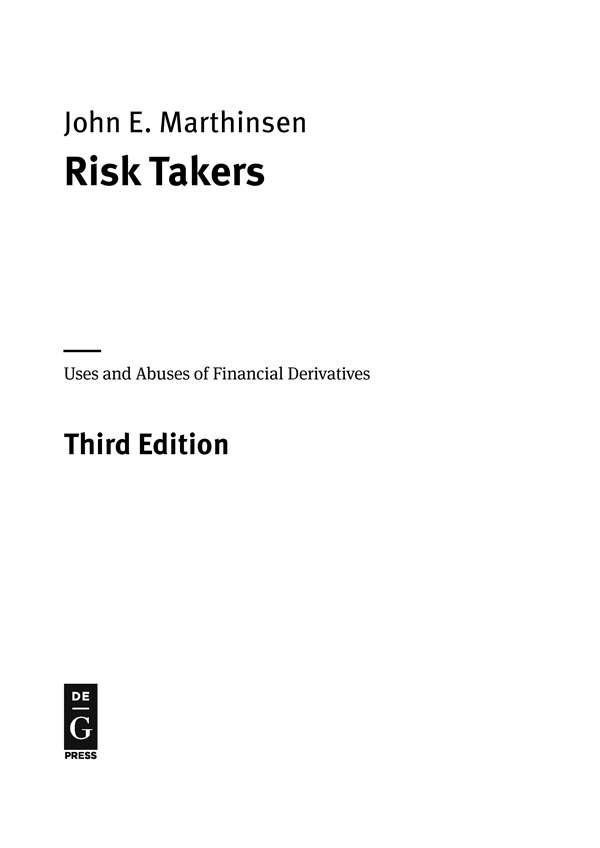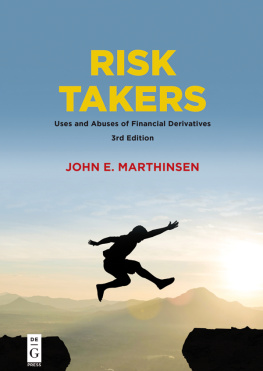Contents
Guide

John E. Marthinsen
Risk Takers

ISBN 978-1-5474-1609-7
e-ISBN (PDF) 978-1-5474-0003-4
e-ISBN (EPUB) 978-1-5474-0005-8
Library of Congress Control Number: 2018937501
Bibliographic information published by the Deutsche Nationalbibliothek
The Deutsche Nationalbibliothek lists this publication in the Deutsche Nationalbibliografie; detailed bibliographic data are available on the Internet at http://dnb.dnb.de.
2018 John E. Marthinsen
Published by Walter de Gruyter Inc., Boston/Berlin
www.degruyter.com

I dedicate this book to my wife, Laraine.
About De|G PRESS
Five Stars as a Rule
De|G PRESS, the startup born out of one of the worlds most venerable publishers, De Gruyter, promises to bring you an unbiased, valuable, and meticulously edited work on important topics in the fields of business, information technology, computing, engineering, and mathematics. By selecting the finest authors to present, without bias, information necessary for their chosen topic for professionals , in the depth you would hope for, we wish to satisfy your needs and earn our five-star ranking.
In keeping with these principles, the books you read from De|G PRESS will be practical, efficient and, if we have done our job right, yield many returns on their price.
We invite businesses to order our books in bulk in print or electronic form as a best solution to meeting the learning needs of your organization, or parts of your organization, in a most cost-effective manner.
There is no better way to learn about a subject in depth than from a book that is efficient, clear, well organized, and information rich. A great book can provide life-changing knowledge. We hope that with De|G PRESS books you will find that to be the case.
Acknowledgments
I take pleasure in thanking my students, colleagues (both at Babson College and other academic institutions), reviewers, editorial staff, librarians, research assistants, and friends for the help they have given me while writing all three editions of Risk Takers: Uses and Abuses of Financial Derivatives . Babson colleagues who provided valuable feedback were John Edmunds, Craig Ehrlich, Robert McAuliffe, Erik Sirri, and Virginia Soybel. Other colleagues, as well as reviewers, students, research assistants, and friends who helped and contributed useful insights were Poonam Bajaj, James Bennett, Dan M. Berkovitz, Jeremy Berkowitz, Antonio Camara, Charles Q. Cao, Don Chance, Mukesh Chaudhry, Patrice Clarke, Octavia Costea, Anna Dodonova, Imad Elhaj, Ekaterina Emm, Michael Haigh, Shantaram Hegde, Ufuk Ince, Francis Laatsch, Blake LeBaron, John A. MacDonald, Craig Marthinsen, Stewart Mayhew, Robert Merton, Lalatendu Misra, Valerie Nicholas, James Overdahl, Daniel A. Rogers, Eric Rosenfeld, Amareshwar Sahay, Glen Stevens, Nicholas Valeio III, Niklas Wagner, Jill Wetmore, and Hongmin Zi.
Among the editorial staff and librarians who provided valuable assistance were Donna Battista, Patricia Berens, Kathryn Dinovo, Kristin Djorup, Meredith Gertz, Christina Gleason, Gina Kolenda, Janette Krauss, Maria McColligan, Heather McNally, and Kerri McQueen, Deb Meredith, and Deb Tokars.
Special thanks go to the staff at De Gruyter for their work in producing the third edition of Risk Takers: Uses and Abuses of Financial Derivatives . Among the team were Jaya Dalal, Michael C. Thomsett, tech reviewer, Katja Brockmann, production manager, and MacPS, LLC, responsible for typesetting and proofing the manuscript. It has been a pleasure working with Jeffrey M. Pepper, Editorial Director, who worked carefully on this book.
With all the time and effort that went into proofreading each chapter, my sincere hope is it resulted in an error-free book, but I realize this is just a Don Quixote-ish, wishful dream. I warmly invite readers to contact me with any corrections, comments, insights, and/or constructive criticism you have.
Preface
The third edition of Risk Takers: Uses and Abuses of Financial Derivatives follows the precedent set by the second edition, with chapters focusing on the abuses of financial derivatives continuing to displace those explaining their beneficial uses. Yes, there is solace in knowing the same is true of financial stories we read and hear about every day. After all, when was the last time the news focused on a company using derivative instruments to stabilize revenues and costs, provide more job security to its employees, increase chances for continuous debt repayment, enhance shareholders long-term returns, or provide management with good-nights rest, knowing they were able to transfer to others risks that they were either unwilling or unable to bear themselves? My guess is you have seldom, if ever, read such stories or heard them reported on the evening news. Nevertheless, these good derivative uses occur every day and their gains far offset losses from reckless and unlawful uses.
Famous derivative fiascos, such as the ones explained in this book, rarely occur, but when they do, it is human nature to be interested in the how, who , and when surrounding them. Generically, there are two types of fiasco narratives. The first, which is the one I find more interesting, focuses on derivative losses caused by failed strategies. The second focuses on derivative losses caused by individuals who committed fraud, deception, and deceit.
In either case, its personal for me because the ages of individuals behind many of these stories were about the same as my students are now. I like to think that the wrongdoers were, basically, good people who just made very bad, out-of-character decisions for a short period of their lives. The problem was (and continues to be) that large derivative risks and losses can accumulate so quickly that it becomes virtually impossible to reverse them. As you might expect, the derivative perpetrators identified in this book were fired, but their acts also destroyed future job prospects, irreparably tarnished once-stellar reputations, and ruined personal relationships; some went to jail. As you go through this book, ask yourself one simple question: If you were responsible for any of these famous financial fiascos, what would you pay to put your job, employment prospects, reputation, and personal relationships back the way they were? Making a poor decision is a bit like grabbing onto a rope hanging from a rising hot air balloon. If you dont let go immediately, you cant let go at all.
A second precedent that Risk Takers third edition follows is providing readers with more examples, insights, and background information on derivative instruments. Where possible, I have also tried to offer a broader picture of the financial controversies and characters involved in these unfortunate episodes.
Purpose of the Book
I wrote Risk Takers as a practical supplement to the Risk Management course that I teach at Babson College in Babson Park, Massachusetts. This book is not a substitute for the rigorous mathematical and empirical information needed to understand the theoretical backbone of finance or the intricacies of derivative valuation. My goal is more modest, aiming to write an accessible book that helps bridge the gap between theory and practice. Based on my experiences, there are already excellent textbooks that focus on derivative instruments and risk-management techniques, but they are often technical, equation-heavy, and presume considerable knowledge of finance. As a result, their strength in rigor is a weakness in terms of accessibility. I have tried to make the analyses in this book understandable to readers at all levels. The real-life events discussed here provide a contextual framework for understanding and evaluating the potential risks and returns of derivative instruments. In those situations where support might be needed to understand a derivative instrument, I have tried to provide it in a user-friendly way.











